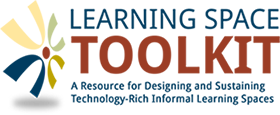Observation: Overview
Formal observation of users is an inexpensive method for discovering more about learners’ behaviors and uses of existing spaces. Observation can lead you to new information about your users and take you into environments at your organization where you don’t often go. The primary purpose of observations is to describe. Observation descriptions should include a description of the setting, any activities that occur in that setting, the individuals who were involved in the activities, and the significance of what was observed. Combining observation with photo-taking can lead to even richer information gathering about how learners use existing spaces.
Strengths
- Inexpensive, only requires staff time and note-taking materials
- Can be used to gather evidence of actual behaviors in a space rather than reported behaviors; allows researcher to test assumptions about spaces, technologies, and other features
- Enables staff to notice more deeply the activities routinely going on around them and to experience spaces and activities at less familiar locations at the institution
Weaknesses
- Validity and reliability of the data may be affected if the people in a setting know they are being observed
- Difficult to assess preferences and opinions from observation alone
